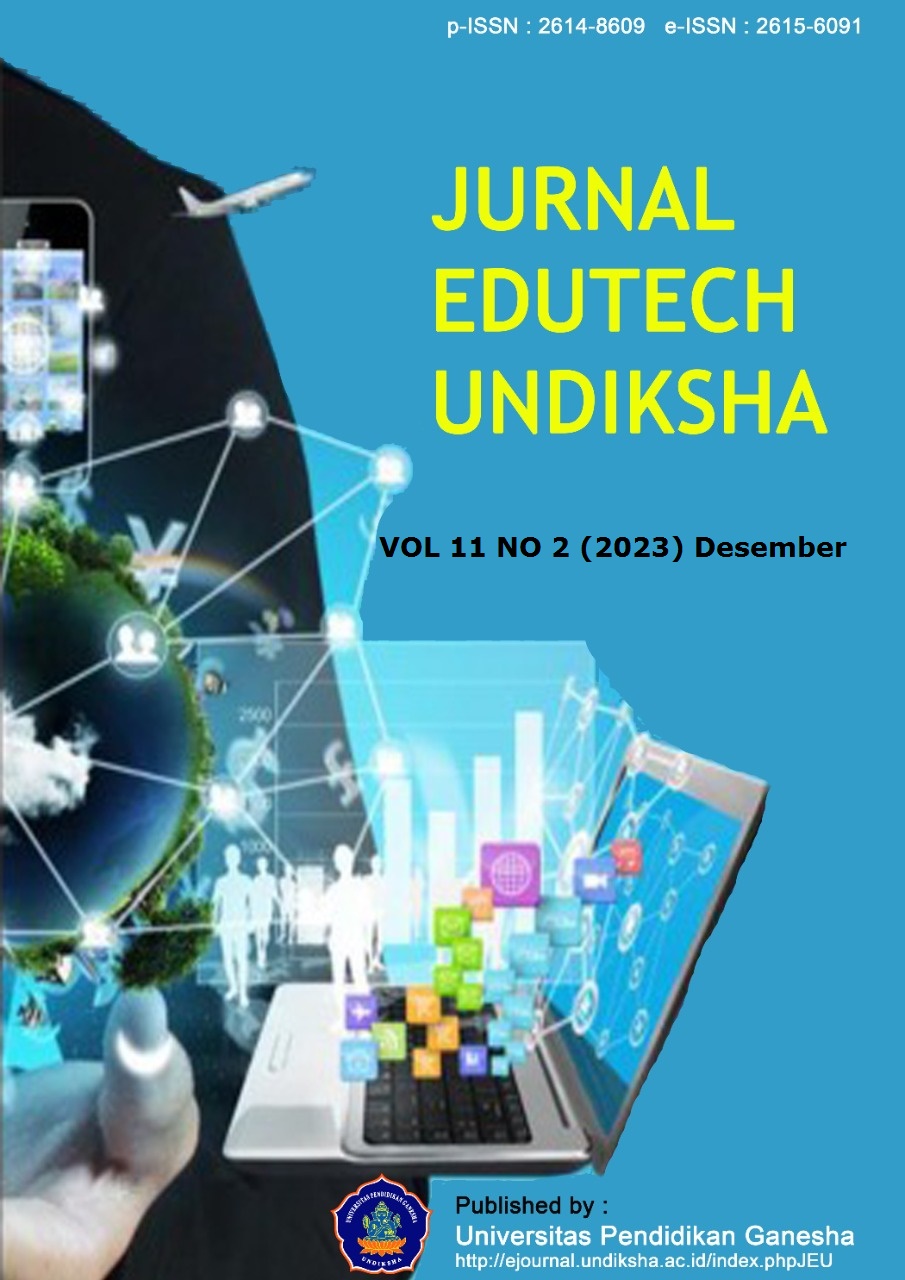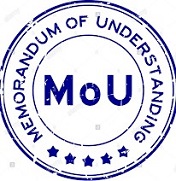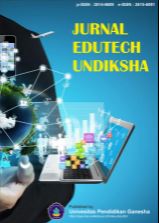Problem Based Learning Animation Videos in Third Grade Indonesian Language Lesson Content
DOI:
https://doi.org/10.23887/jeu.v11i2.63287Keywords:
Animation Video, PBL, Indonesian LanguageAbstract
The learning process implemented in schools tends to be teacher-centered, so students wait for explanations of material from the teacher. This condition results in students needing help answering various problems and issues encountered in the learning process. This research aims to create problem-based learning animation videos for Class III Indonesian language content. This research uses ADDIE development research. The subjects of this research consisted of 1 learning design expert, 1 learning media expert, 1 learning content expert, individual testing (3 students), and small groups (9 students). The data collection method was obtained using the test and questionnaire method—quantitative and qualitative data analysis techniques. The results of this research show the validity of the learning design expert with a score of 95%, the learning content expert with a score of 94.54%, the learning design expert with a score of 86.15%, the results of individual trials with a score of 88.66%, and the results of small group trials namely a score of 89%. The effectiveness of learning media can be seen from the t-test with the calculated t value of 17.247 and t table of 1.717. The conclusion is that there is a significant difference in student learning outcomes between before and after using problem-based learning animated video media. This research implies that teachers can use the media in teaching, making it easier for students to understand the lesson material.
References
Abduh, M., & Istiqomah, A. (2021). Content Analysis of Hots and 21st Century Skills in Class V Student Books on Ecosystem Themes in Elementary Schools. Basicedu Journal, 5(4), 2069–2081. https://doi.org/10.31004/basicedu.v5i4.1124.
Adi, WA, Relmasita, SC, & Hardini, AT (2020). Development of Animation Media for Mathematics Learning with Flat Figure Material. Journal of Educational Research and Development, 4(1), 81. https://doi.org/10.23887/jppp.v4i1.24778.
Ahmet, A., Gamze, K., Rustem, M., & Karaborklu Argut, S. (2018). Is Video-Based Education an Effective Method in Surgical Education? A Systematic Review. Journal of Surgical Education, 75(5), 1150–1158. https://doi.org/10.1016/j.jsurg.2018.01.014.
Anak Agung Gede Agung. (2017). Inferential Statistics for Education. Undiksha Singaraja.
Apriansyah, MR (2020). Development of Animation-Based Video Learning Media for Building Materials Science Courses in the Building Engineering Education Study Program, Faculty of Engineering, Jakarta State University. Pencil Journal, 9(1), 9–18. https://doi.org/10.21009/jpensil.v9i1.12905.
Arditya Isti, L., Agustiningsih, & Aguk Wardoyo, A. (2020). Development of an animated video on the properties of light for fourth grade elementary school students. Journal of Elementary Education, 1(1), 21–28. https://doi.org/10.26740/eds.v4n1.p21-28.
Cahyadi, RAH (2019). Development of Teaching Materials Based on the Addie Model. Halaqa: Islamic Education Journal, 3(1), 35–42. https://doi.org/10.21070/halaqa.v3i1.2124.
Candra Dewi, NML, & Negara, IGAO (2021). Development of Science Animation Video Media on the Respiratory System Subject for Class V. Undiksha Edutech Journal, 9(1), 270–277. https://doi.org/10.23887/jeu.v9i1.32501.
Desmirasari, R., & Oktavia, Y. (2022). The Importance of Indonesian in Higher Education. ALINEA: Journal of Language, Literature and Teaching, 2(1), 114–119. https://doi.org/10.58218/alinea.v2i1.172.
Dewi, FF, & Handayani, SL (2021). Development of En-Alter Sources Animation Video Learning Media Based on the Powtoon Application for Elementary School Alternative Energy Source Materials. Basicedu Journal, 5(4), 2530–2540. https://doi.org/10.31004/basicedu.v5i4.1229.
Effendi, R., Herpratiwi, & Sutiarso, S. (2021). Development of Mathematics LKPD Based on Problem Based Learning in Elementary Schools. Basicedu Journal, 5(2), 920–929. https://doi.org/10.31004/basicedu.v5i2.846.
Fuada, S., & Marhamah, M. (2021). Read Aloud Video as an Online Learning Media during the Covid-19 Pandemic at Aisyiyah Kindergarten Sidoharjo - Wonogiri. International Journal of Community Service Learning, 5(2), 151–161. https://doi.org/10.23887/ijcsl.v5i2.33577.
Ganing, NN, & Wulandari, IGAA (2023). Animation Video Media Using Directed Reading Thinking Activity (DRTA) Strategies Improve Reading Understanding of Indonesian Language. International Journal of Elementary Education, 7(2), 178–186. https://doi.org/10.23887/ijee.v7i2.61717.
Gusmida, R., & Islami, N. (2017). The Development of Learning Media for the Kinetic Theory of Gases Using the ADDIE Model with Augmented Reality. Journal of Educational Sciences, 1(1), 1. https://doi.org/10.31258/jes.1.1.p.1-10.
Hamidi, K., Jamaluddin, W., Koderi, K., & Erlina, E. (2023). Development of Arabic Language Learning Media Based on Interactive Animation Videos for Madrasah Aliyah Students. Journal on Education, 5(2), 5289–5296. https://doi.org/10.31004/joe.v5i2.1098.
Hapsari, GPP, & Zulherman, Z. (2021). Development of animated video media based on the Canva application to increase student motivation and learning achievement. Basicedu Journal, 5(4), 2384–2394. https://doi.org/10.31004/basicedu.v5i4.1237.
Hidayat, F., & Nizar, M. (2021). Addie Model (Analysis, Design, Development, Implementation and Evaluation) in Islamic Religious Education Learning. Journal of Islamic Religious Education Innovation (JIPAI), 1(1), 28–38. https://doi.org/10.15575/jipai.v1i1.11042.
Hita, A., Shifa, AFA, & Gumelar, MRM (2021). Improving Learning Through Animation Video Learning Media for Elementary Schools. Curriculum Innovation, 18(1), 115–127. https://doi.org/10.17509/jik.v18i1.42680.
Isnaeni, N., & Hildayah, D. (2020). Learning Media in Forming Student Learning Interactions. Journal of Syntax Transformation, 1(5), 148–156. https://doi.org/10.46799/jst.v1i5.69.
LaForce, M., Noble, E., & Blackwell, C. (2017). Problem-Based Learning (PBL) and Student Interest in STEM Careers: The Roles of Motivation and Ability Beliefs. Education Sciences, 7(4), 92. https://doi.org/10.3390/educsci7040092.
Lestari, RD, & Astuti, EY (2023). Development of Javanese Language Animation Videos as Uploaded Educational Media for Toddlers. 7(3), 2759–2768. https://doi.org/10.31004/obsesi.v7i3.4329.
Liberta Loviana Carolin, I Ketut Budaya Astra, & I Gede Suwiwa. (2020). Development of Learning Video Media Using the Addie Model on Basic Techniques for Pencak Silat Kicks for Class VII of SMP Negeri 4 Sukasada for the 2019/2020 Academic Year. Journal of Kejaora (Physical Health and Sports), 5(2), 12–18. https://doi.org/10.36526/kejaora.v5i2.934.
Made, I., Saputra, M., Bagus, I., & Manuaba, S. (2021). Project-Based Animation Video Media in Natural Appearance Material for Social Sciences Subjects. Journal of Educational Research and Development, 5(1), 10–16. https://ejournal.undiksha.ac.id/index.php/JJL/index.
Mashuri, DK, & Budiyono. (2020). Development of Animation Video Learning Media Volume Building Materials for Elementary Class V. Development of Animation Video Media, 8(5), 893–903. https://ejournal.unesa.ac.id/index.php/jurnal-penelitian-pgsd/article/view/35876.
Masliah, L., Nirmala, SD, & Sugilar, S. (2023). The Effectiveness of the Problem Based Learning (PBL) Learning Model on the Literacy and Numeracy Abilities of Students in Elementary Schools. Basicedu Journal, 7(1), 1–10. https://doi.org/10.31004/basicedu.v7i1.4106.
Mayang Ayu Sunami, & Aslam. (2021). The Effect of Using Zoom Meeting-Based Animation Video Learning Media on Primary School Students' Interest and Science Learning Outcomes. Basicedu Journal, 5(4), 1–9. https://doi.org/10.31004/basicedu.v5i4.1129.
Megawati, & Utami. (2020). English Learning with Powtoon Animation Video. Journal of Educational Technology, 4(2), 110. https://doi.org/10.23887/jet.v4i2.25096.
Muga, W., & DNL, L. (2017). Development of Electronic Teaching Materials Based on the Problem Based Learning Model Using the Dick and Carey Model. Journal of Educational Technology, 1(4), 260–264. https://doi.org/10.23887/jet.v1i4.12863.
Mulyani, S. (2020). Application of Problem Based Learning Methods to Improve Science Learning Outcomes During the Covid 19 Pandemic. Navigation Physics: Journal of Physics Education, 2(2), 84–89. https://doi.org/10.30998/npjpe.v2i2.489.
Muslina, M., Halim, A., & Khaldun, I. (2018). Feasibility of Animation Media Newton's Law II Regarding Motion on Inclined Planes and Pulleys in High Schools in Aceh Besar Regency. Journal of Science & Science Learning, 1(1), 64–72. https://doi.org/10.24815/jipi.v1i1.9568.
Najihah, M., Purwo, A., Utomo, Y., & Safitri, AN (2023). Utilization of YouTube for Learning Indonesian Explanatory Text Material in Middle School. Journal of Education and Social Sciences, 1(2), 45–59. https://doi.org/10.54066/jupendis-itb.v1i2.109.
Novellia, M. (2018). Application of the problem based learning (PBL) learning model to improve creative thinking abilities and student learning outcomes in thematic learning. Journal for Lesson and Learning Studies, 1(2), 149–156. https://doi.org/10.23887/jlls.v1i2.14760.
Nurrahmah, F. (2023). Strengthening Indonesian as a National Identity Through Interactive Posters on Instagram @Bastra.Id. Educaniora: Journal of Education and Humanities, 1(1), 10–16. https://doi.org/10.59687/educaniora.v1i1.3.
Pepadu, J., Artayasa, IP, Muhlis, M., Hadiprayitno, G., & Sukarso, A. (2022). Counseling on the Use of Animation Videos for Learning During the Covid-2019 Pandemic at SMPN 3 Mataram. Pepadu Journal, 3(1), 82–90. https://doi.org/10.29303/pepadu.v3i1.2305.
Pranata, IMA, & Jayanta, INL (2021). Improving Students' Comprehension about Energy Sources through Sparkol Videoscribe-Based Learning Media. Elementary School Science Journal, 5(2), 212–221. https://doi.org/10.23887/jisd.v5i2.35804.
Purnomo, WSA, & Anshory, I. (2020). The Role of the Principal in Improving the Quality of Education at Muhammadiyah 4 Malang Elementary School. Journal of Educational Policy and Development, 7(1). https://doi.org/10.22219/jkpp.v7i1.12036.
Putri, AG, Ganing, NN, & Kristiantari, MGR (2022). Animated Video on Solar System Material Oriented to Problem Based Learning in Elementary School Learning. Journal for Lesson and Learning Studies, 5(1), 106–116. https://doi.org/10.23887/jlls.v5i1.45842.
Putri Laras Sati, Petrus Poerwadi, Yuliati Eka Asi, Alifiah Nurachmana, & Stefani Ratu Lestariningtyas. (2023). Principles of Politeness in Language in the Film Kite Sangat and Its Implications for Indonesian Language Learning in Middle Schools. PROCEEDINGS OF THE NATIONAL SEMINAR ON EDUCATION, LANGUAGE, LITERATURE, ARTS, AND CULTURE, 2(1), 108–125. https://doi.org/10.55606/mateandrau.v2i1.224.
Rahayu, W. (2023). Use and Meaning of Indonesian in the Era of Globalization. Journal of Multidisciplinary Research, 2(1), 158–162. https://doi.org/10.58705/jpm.v2i1.117.
Rahmadani. (2019). Method of Implementing the Problem Based Learning (Pbl) Learning Model. Lanthanide Journal, 7(1), 75. https://doi.org/10.22373/lj.v7i1.4440.
Rohaeni, S. (2020). Development of a Learning System in Implementing the 2013 Curriculum Using the Addie Model in Early Childhood. Instructional, 1(2), 122. https://doi.org/10.24853/instructional.1.2.122-130.
Roza, M.A. (2020). Development of Contextually Based Animation Videos in Class V Science Lessons in Elementary Schools. Journal of Basic Education Research, 1(3), 87–92. https://doi.org/10.37251/jber.v1i3.108.
Salam, S. (2022). A systemic review of Problem-Based Learning (PBL) and Computational Thinking (CT) in teaching and learning. International Journal of Humanities and Innovation (IJHI), 5(2), 46–52. https://doi.org/10.33750/ijhi.v5i2.145.
Saltan, F., & Faruk, O. (2017). Using Blogs to Improve Elementary School Students' Environmental Literacy in Science Class. European Journal of Educational Research, 6(3), 347–355. https://doi.org/10.12973/eu-jer.6.3.347.
Satyawan, V. (2018). The Use Of Animation Videos To Teach English At Junior High School Students. Jellt (Journal of English Language and Language Teaching), 2(2), 89–96. https://doi.org/10.36597/jellt.v2i2.3277.
Savitri, KPB, & Manuaba, IBS (2022). Development of PBL Model-Based Animation Videos as Indonesian Language Content Learning Media for Class V Students. Journal of Education and Counseling (JPDK), 4(2), 344–354. https://doi.org/10.31004/jpdk.v4i2.4070.
Semara, TA, & Agung, AAG (2021). Development of Animation Videos for Class IV Elementary School Science Lesson Content. Undiksha Science Forum, 26(1), 99–107. https://doi.org/10.23887/mi.v26i1.32104.
Veranda of Mecca Banda Aceh, U. (2022). Contextal Teaching and Learning Concept in Efforts to Create a Fun and Meaningful Teaching and Learning Climate. In Journal of Education and Teaching (Vol. 1, Issue 1). http://pedirresearchinstitute.or.id/index.php/Jurpen.
Setiadi, G., & Nurma Yuwita. (2020). Development of Indonesian Language Course Modules Using the Addie Model for Iai Sunan Kalijogo Malang Students. Academics: Journal of Islamic Education Management, 2(2), 200–217. https://doi.org/10.51339/akademika.v2i2.207.
Subaini, S., Irvan, I., & Nasution, MD (2022). The Influence of the Problem-Based Learning Model on Students' Mathematical Critical Thinking Ability. Nusantara MathEducation Journal, 5(2), 16. https://doi.org/10.54314/jmn.v5i2.231.
Sukarini, K., & Manuaba, IBS (2021). Development of Online Learning Animation Videos for Class VI Elementary School Science Subjects. Undiksha Edutech Journal, 9(1), 60–68. https://doi.org/10.23887/jeu.v9i1.32347.
Taqiya, Nuroso, & Reffiane. (2019). The Influence of the Connected Type Integrated Learning Model Assisted by Animation Video Media. Pulpit PGSD Undiksha, 7(3), 289–295. https://doi.org/10.23887/jjpgsd.v7i3.19492.
Wardani, RK, & Syofyan, H. (2018). Development of Interactive Videos in Integrative Thematic Science Learning on Human Blood Circulation Material. Elementary School Science Journal, 2(4), 371–381. https://doi.org/10.23887/jisd.v2i4.16154.
Widiarti, NK, Sudarma, IK, & Tegeh, IM (2021). Improving Mathematics Learning Outcomes for Grade V Elementary School Through Learning Video Media. Undiksha Edutech Journal, 9(2), 195. https://doi.org/10.23887/jeu.v9i2.38376.
Widiyasanti, M., & Ayriza, Y. (2018). Development of Animation Video Media to Increase Learning Motivation and Character Responsibility of Class V Students. Journal of Character Education, 9(1), 1–16. https://doi.org/10.21831/jpk.v8i1.21489.
Yusa, AAGD, & Sukmana, AIWIY (2022). Animation-Based Two-Dimensional Geometry Learning Video for Grade IV Elementary School Students. Pulpit PGSD, 10(3), 533–540. https://doi.org/10.23887/jjpgsd.v10i3.51372.
Zakiah, NE, Sunaryo, Y., & Amam, A. (2019). Implementation of a Contextual Approach in the Problem Based Learning Model Based on Polya's Steps. Theorem: Mathematical Theory And Research, 4(2), 111. https://doi.org/10.25157/teorema.v4i2.2706.
Downloads
Published
How to Cite
Issue
Section
License
Copyright (c) 2023 Ibnu Sina

This work is licensed under a Creative Commons Attribution-ShareAlike 4.0 International License.
Authors who publish with the Jurnal EDUTECH Undiksha agree to the following terms:
- Authors retain copyright and grant the journal the right of first publication with the work simultaneously licensed under a Creative Commons Attribution License (CC BY-SA 4.0) that allows others to share the work with an acknowledgment of the work's authorship and initial publication in this journal.
- Authors are able to enter into separate, additional contractual arrangements for the non-exclusive distribution of the journal's published version of the work (e.g., post it to an institutional repository or publish it in a book), with an acknowledgment of its initial publication in this journal.
- Authors are permitted and encouraged to post their work online (e.g., in institutional repositories or on their website) prior to and during the submission process, as it can lead to productive exchanges, as well as earlier and greater citation of published work. (See The Effect of Open Access)














